The Essential Role of Dignity in Cemetery Burials
When a family gathers at graveside to say their final goodbyes, what they see matters deeply. A casket lowering device might seem like just another piece of funeral equipment, but it's actually the centerpiece of one of life's most solemn moments.
These mechanical marvels do far more than just lower a casket – they preserve the dignity of the deceased and provide comfort to the grieving. If you're wondering what exactly these devices are and why they matter so much, I'm here to help explain.
| Quick Facts: Casket Lowering Devices |
|---|
| Primary Function: Safely lower caskets into graves with controlled descent |
| Weight Capacity: Typically 800-1,000 lbs (362-453 kg) |
| Key Types: Standard, Heavy-duty, Infant/Urn, and Oversized models |
| Average Cost: $4,000-$13,000 depending on model and accessories |
| Common Materials: Stainless steel, cast aluminum, bronze gearing |
That moment when a casket begins its gentle descent represents the physical transition we all understand emotionally. Behind this seemingly simple act lies impressive engineering that combines safety with respectful presentation. Modern casket lowering devices use sophisticated mechanical systems—typically centrifugal brakes and worm gears—that ensure the casket descends smoothly and steadily, regardless of weight.
For funeral directors, choosing the right equipment isn't just a practical decision—it's about honoring their commitment to families. These devices have come a long way since their early 20th-century origins. Today's models feature telescoping frames that adjust to different grave sizes, sealed bearings that operate silently, and modular designs that adapt to various cemetery conditions.
I'm with American Mortuary Coolers, where we've helped countless funeral homes across the nation find the perfect casket lowering device for their specific needs. Through years of conversations with funeral directors, I've learned how crucial reliable, well-maintained equipment is for providing services that families will remember with appreciation rather than distress.
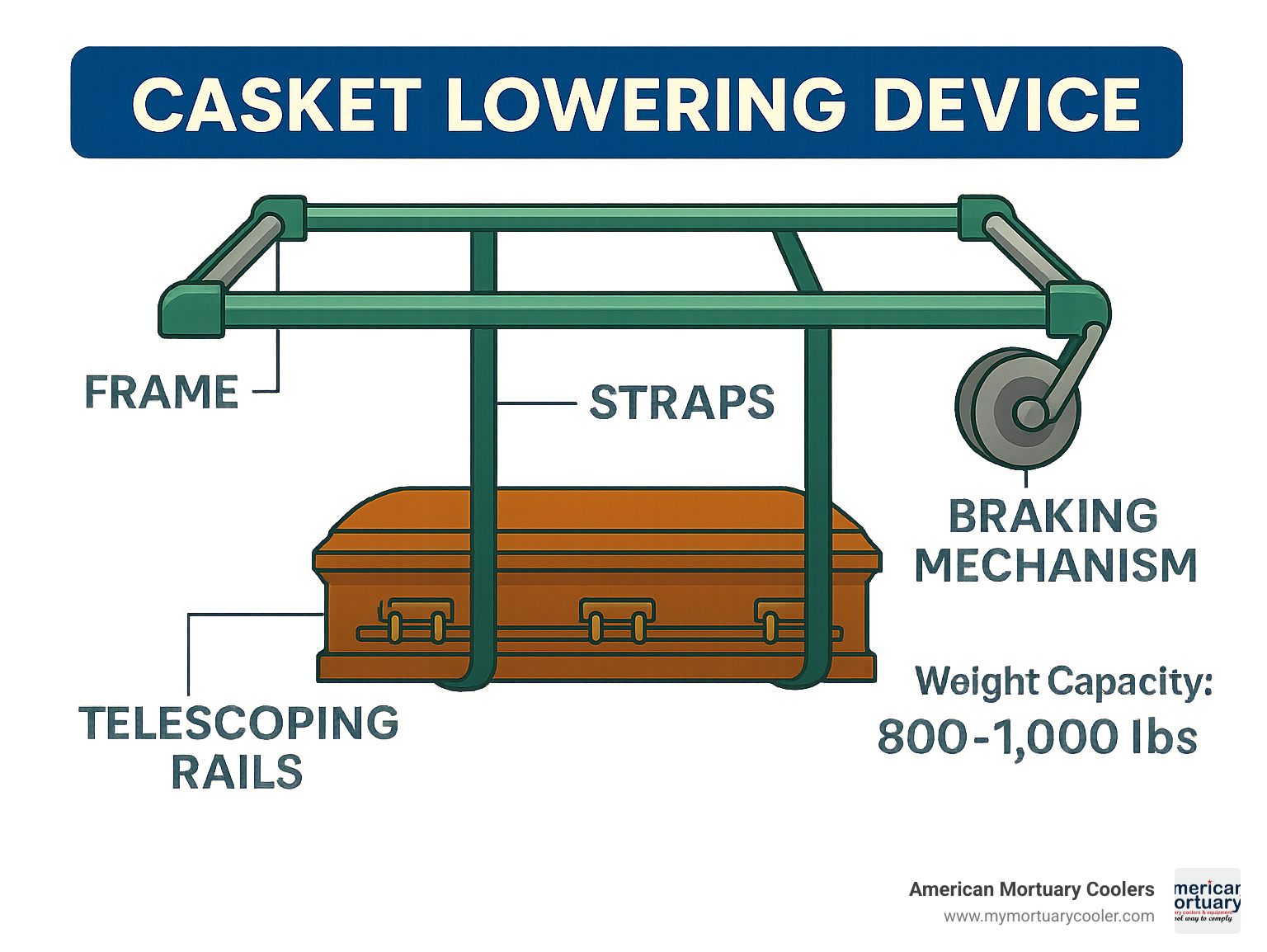
When you're looking into funeral equipment terminology, you might also come across related terms like american mortuary services, tug for racks systems, or mark iv table 2 specifications – all part of the comprehensive equipment that helps funeral professionals provide dignified, safe services.
At American Mortuary Coolers, we understand that behind every piece of equipment is a family's meaningful moment. That's why we take such care in helping you find the right tools for these precious final ceremonies.
How a Casket Lowering Device Works
At its core, a casket lowering device is an neat solution to a challenging practical and emotional need: how to lower a heavy casket into a grave with dignity, control, and safety. Understanding the mechanics behind these devices helps funeral professionals make informed purchasing decisions and deliver the respectful services families deserve.

Modern casket lowering devices blend time-tested mechanical principles with contemporary engineering. Dating back to Charles A. Purvis's 1918 patent, these devices have always aimed to provide "spring and governor-controlled lowering mechanism capable of supporting the casket above the grave and having releasing mechanism for releasing the same to permit the casket to be lowered by its own weight into the grave."
While that fundamental principle remains, today's devices offer remarkable precision and reliability. The basic operation involves a rectangular frame with supporting straps that cradle the casket. When activated, a sophisticated braking system allows for a smooth, controlled descent that maintains the solemnity of the moment.
Casket Lowering Device Mechanics Explained
Think of a casket lowering device as a precision instrument disguised as a simple frame. The magic happens inside its components, where careful engineering creates a seamless experience for those in attendance.
The frame structure forms the backbone of the system, typically crafted from stainless steel and aluminum for durability and weather resistance. Four corner heads connect to telescoping side and end rails, allowing funeral directors to adjust the frame to accommodate different casket sizes.
Across this frame run wide webbing straps, usually 3-7/8" wide, with impressive break weights of approximately 2,000 pounds. These straps bear the casket's weight and connect to internal spools and reels hidden within the side rails. When activated, these spools wind and unwind in perfect synchronization, ensuring the casket descends evenly without tilting.
At the heart of this system lies the worm gear assembly, a mechanical marvel that converts rotational force into controlled linear movement. This provides both mechanical advantage and precision control. The operator uses either a stainless steel crank handle or a simple release mechanism to activate the descent, at which point the braking system takes over, allowing the straps to unwind at a dignified, measured pace.
After the casket reaches its final resting place, the straps can be easily removed, and the device disassembled or relocated for another service. The entire process combines engineering excellence with respectful ceremony, as detailed in Casket Lowering in a Conventional Cemetery Burial.
Casket Lowering Device Weight & Speed Regulation
Perhaps the most impressive aspect of a quality casket lowering device is its ability to maintain consistent lowering speed regardless of the casket's weight. This consistency is crucial for maintaining the dignity of the service.
The centrifugal governor lies at the center of this capability. This ingenious mechanical device automatically adjusts braking force based on rotational speed. As W. Maechler explained in his 1922 patent: "One of the objects is to provide an arrangement such that the rapidity of the descent may be made practically the same regardless of the weight of the casket."
Modern devices like the Frigid Master take this further with infinitely adjustable braking systems, allowing funeral directors to fine-tune the descent speed to match the tone of each unique service. This customization helps create the right atmosphere for families during this meaningful moment.
Today's premium devices offer impressive load ratings, with top models handling up to 1,000 lbs (453 kg). The Frigid Master leads the industry with this capacity, while the Revolution Lowering Device supports up to 900 lbs (408 kg) and the Frigid Imperial handles up to 800 lbs (362 kg).
What this means in practice is remarkable consistency – whether lowering a lightweight casket or one approaching the device's maximum capacity, the descent takes approximately one minute. This steady, dignified pace creates a moment of reflection and closure for those present, changing a practical necessity into a meaningful part of the farewell ceremony.
Comparing Major Types and Models
When selecting a casket lowering device, funeral professionals face a range of options designed for different needs and budgets. Let's walk through the major types and models you'll encounter in today's market.
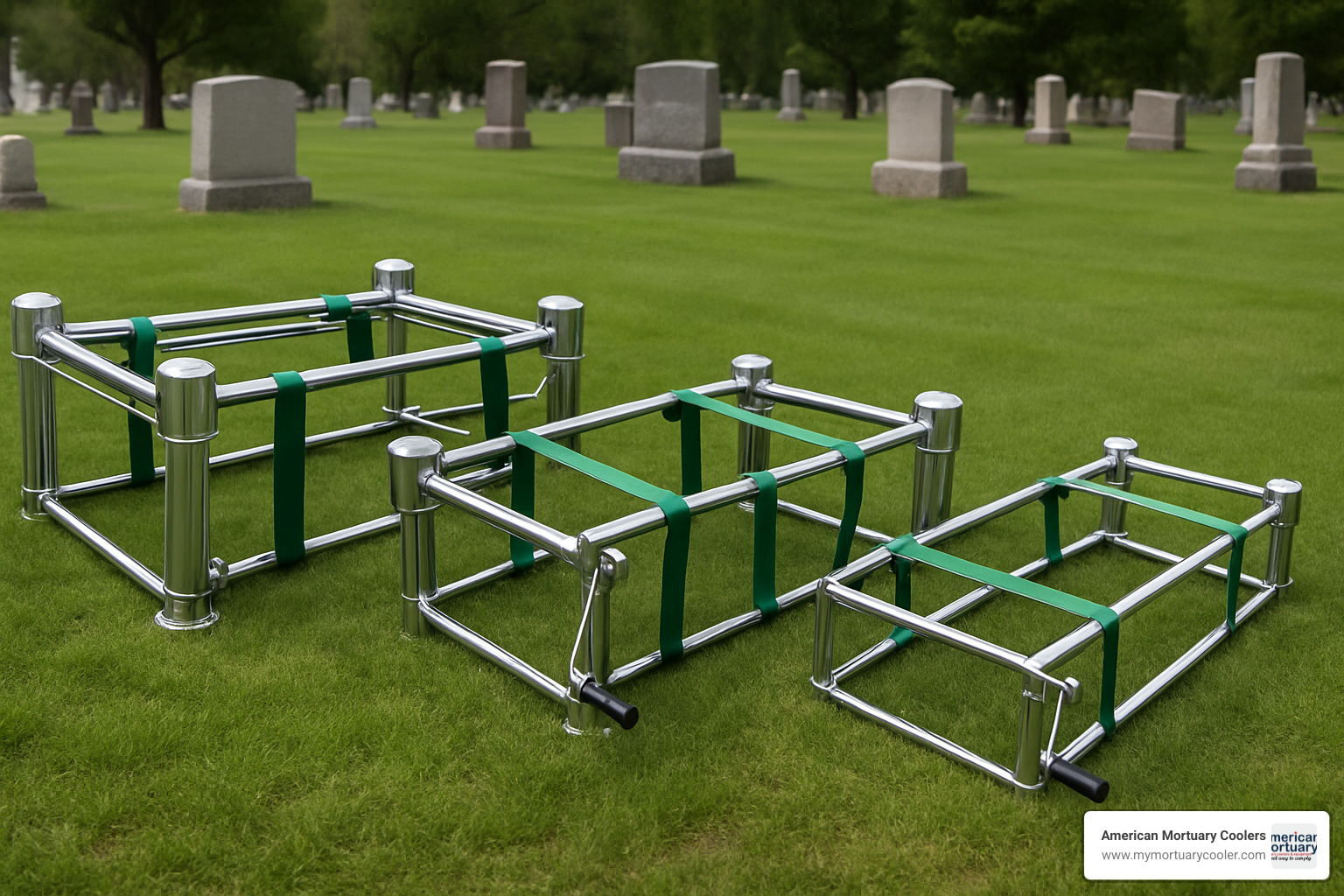
| Model | Weight Capacity | Device Weight | Dimensions (Closed) | Dimensions (Extended) | Notable Features | Approx. Price |
|---|---|---|---|---|---|---|
| Frigid Master | 1,000 lbs | 125-170 lbs | 58"L x 22"W x 6.5"H | 92"L x 34"W x 6.5"H | Heavy-duty, optional placer arms | $5,000-7,000 |
| Frigid Imperial | 800 lbs | 110 lbs | 62"L x 26"W | 94"L x 38"W | Telescoping frame, adjustable braking | $4,600-5,500 |
| Revolution | 900 lbs | 90 lbs | 61"L x 25"W | 96"L x 37"W | Heavy-wall stainless steel tubing | $4,500-6,000 |
| Junkin | 360 kg (794 lbs) | 57 kg (126 lbs) | 186 x 97 x 16 cm | 234 x 90 x 16 cm | Modular construction, steel/bronze mechanism | $4,000-5,500 |
| Frigid Streamliner Combo | 1,000 lbs | 170+ lbs | 58"L x 22"W x 6.5"H | 92"L x 34"W x 6.5"H | Includes mobile cart with towbar | $13,000+ |
| Infant/Urn Device | 362 kg (800 lbs) | 28 kg (62 lbs) | 126 x 67 x 17 cm | 91 x 52 x 17 cm | One-person operation, includes stand | $5,600+ |
Standard & Heavy-Duty Units
Standard and heavy-duty casket lowering devices are the workhorses of the funeral industry. Think of them as the reliable pickup trucks in your equipment fleet – built for everyday use with adult-sized caskets.
The Frigid Master stands as the gold standard for heavy-duty applications. With components twice the size of the Imperial model, it's the go-to choice when reliability and durability can't be compromised. Its impressive 1,000 lb capacity handles even the heaviest caskets with ease, making it perfect for busy funeral homes and cemeteries that can't afford equipment failures.
Many of our customers love the Frigid Imperial for its sweet-spot balance of quality and value. With an 800 lb capacity and telescoping design that adjusts from 62" × 26" to 94" × 38", it accommodates most standard caskets while being a bit lighter on both your back and your budget.
The Revolution Lowering Device offers a compelling middle ground with its 900 lb capacity. At just 90 lbs, it's more manageable for transport between locations while still featuring heavy-wall stainless steel tubing that stands up to the elements year after year.
All these standard models include telescoping frames, sealed self-lubricating bearings, adjustable braking systems, and ISO:9001 certified stainless-steel rails. As one funeral director told us, "The casket lowering device makes all the difference in the ceremony's dignity. Families notice when the lowering is smooth and controlled – it reflects on our professionalism."
Oversized & Bariatric Solutions
With America's changing demographics, oversized casket lowering devices have become essential equipment for forward-thinking funeral homes.
These specialized units feature wider frames and longer telescoping rails to accommodate larger caskets. They're built with reinforced construction, extra-long straps with higher break weights, and improved braking systems designed specifically for heavier loads.
The Frigid Master and Streamliner models offer excellent oversized options. They maintain the same smooth operation you expect, just with expanded dimensions and beefed-up components to handle the additional stress without compromising safety.
When helping funeral homes select an oversized unit, we always recommend considering both the maximum width and length needed, as well as the weight capacity. Some situations call for custom dimensions – something we at American Mortuary Coolers can help arrange for our customers nationwide, from New York to Los Angeles and everywhere in between.
Infant & Urn Lowerers
For life's most heartbreaking services – those for infants or cremation urns – specialized casket lowering devices provide appropriate scale and dignity.
The Infant/Urn Lowering Device (sometimes called the Simplicity model) is thoughtfully designed for these smaller caskets and urns. It's built for one-person operation with a hand-brake release mechanism and comes in a compact size (typically 91 × 52 × 17 cm when assembled). Each unit includes a stand, display board, and drape, all in a package weighing about 28 kg (62 lbs).
Despite their smaller size, these devices don't compromise on quality. They maintain a substantial load capacity of up to 362 kg (800 lbs) and provide the same smooth, controlled lowering mechanism that families deserve regardless of the service size.
As one of our funeral director clients shared with us, "The specialized infant lowering device lets us offer the same dignity to grieving parents that we provide for any other family. In the most difficult moments, having the right equipment helps us focus on supporting the family rather than worrying about logistics."
Key Buying Factors: Features, Materials & Specifications for Your Casket Lowering Device
Selecting the right casket lowering device requires careful consideration of materials, features, and specifications that will determine its durability, functionality, and value over time.
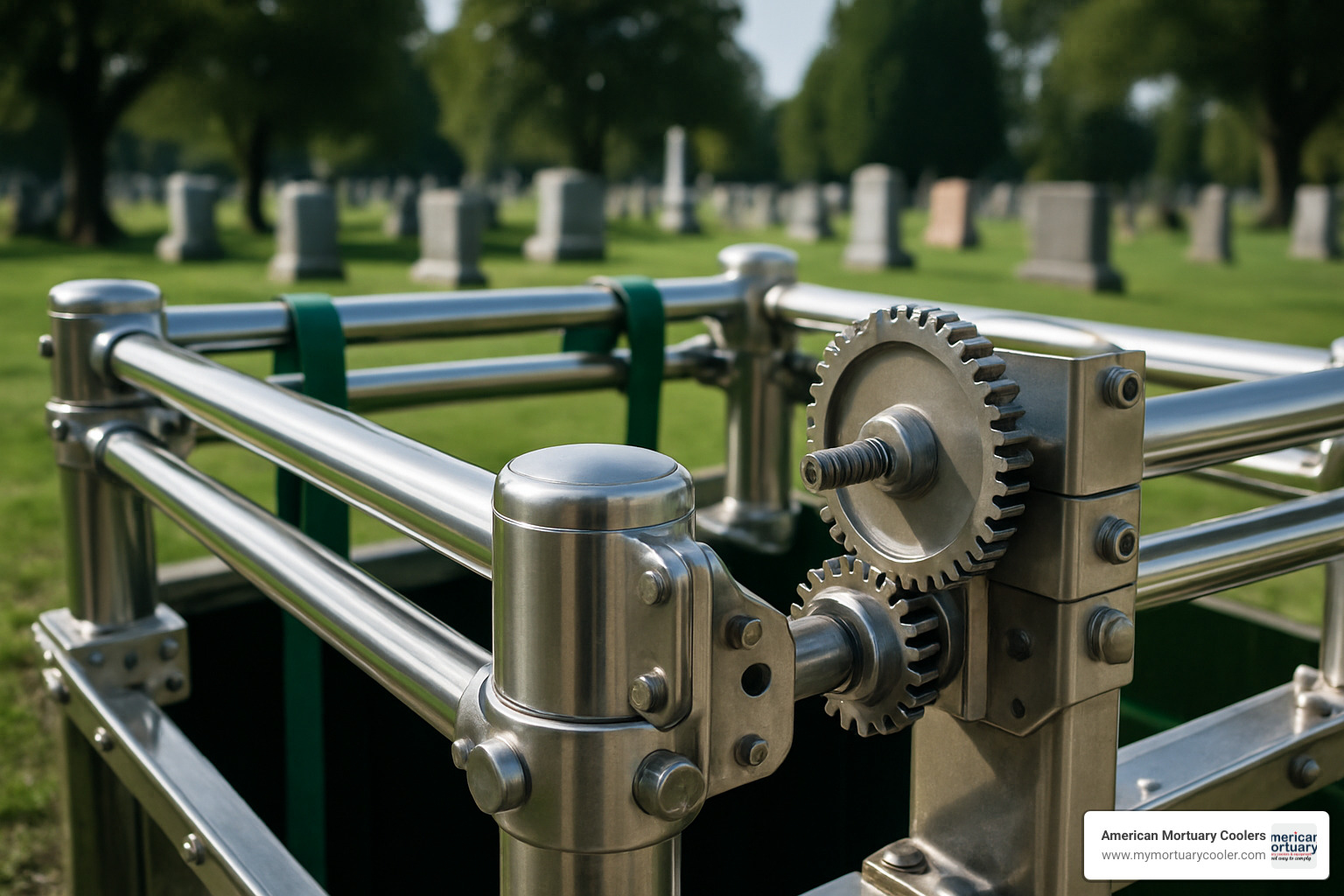
Frame Materials & Corrosion Resistance
When it comes to casket lowering devices, what they're made of matters tremendously. These aren't indoor pieces of equipment – they face rain, snow, soil, and all manner of environmental challenges while needing to perform flawlessly during emotional moments.
Premium devices feature ISO-9001 certified stainless steel tubing that stands up to the elements year after year. I've seen how this material maintains its integrity even after hundreds of services in all weather conditions. The difference between standard steel and quality stainless becomes apparent after just one season of use.
The corner heads on top-tier models like the Frigid Master and Imperial are crafted from polished cast aluminum. This isn't just about looks – aluminum provides that perfect balance of strength without excessive weight, making setup and transportation manageable for funeral staff. Plus, it simply doesn't corrode the way other metals might.
When examining the internal components, quality really shows itself. The best casket lowering devices contain precision gearing made from tempered steel and bronze – you won't find plastic or nylon in critical mechanical areas of reputable brands. As one cemetery director told me, "Those plastic gears might save a few hundred dollars up front, but they'll cost you thousands in reputation when they fail during a service."
Many manufacturers add specialized weatherproof coatings as an extra layer of protection. Combined with self-lubricating sealed bearings that keep dirt and moisture out, these features ensure smooth, reliable operation service after service, year after year.
Must-Have Accessories
A casket lowering device isn't complete without several essential accessories that transform it from a mechanical apparatus into a dignified ceremonial tool.
The straps are your first consideration – standard sets run about 20 feet long and 3-7/8 inches wide, with break weights around 2,000 pounds. Good straps cost between $60-$102 depending on length and quality, and they're worth every penny. Safety chains provide crucial backup security during lowering, typically measuring 54 inches (68 inches with hooks) and priced around $40-50 per pair.
For busy cemeteries handling multiple services daily, the Frigid Streamliner cart is a game-changer. Not only does it protect your investment by safely transporting the device, but it also saves staff from back strain. As one cemetery manager shared with me, "Before we got the Streamliner, our guys were exhausted by the third service of the day. Now they can focus on the families instead of their aching backs."
The visual presentation matters tremendously too. Quality drape sets conceal the mechanical aspects of the device, creating a more dignified atmosphere. Whether you choose single-faced, double-faced, polyester, or hyluster materials, expect to invest $300-500 for drapes that will improve the visual experience for grieving families.
Proper positioning requires a telescoping device stand that adjusts in multiple dimensions to accommodate various grave sizes. These stands typically adjust from 17"–27" in height, 36"–54" in width, and 57"–102" in length, with prices around $800-1,200.
Don't overlook placer arms and roller sets – these simple additions make positioning the casket much easier and reduce physical strain on your staff. At around $500-700, they're a worthwhile addition that pays dividends in smoother services.
At American Mortuary Coolers, we've found that funeral homes who purchase complete systems rather than piecing together components tend to have fewer compatibility issues and better long-term performance. It's one area where a comprehensive approach truly makes sense.
Future-Proof Specs & Upgrades
Investing in a casket lowering device means thinking about tomorrow's needs, not just today's. The funeral industry evolves, and your equipment should be able to adapt accordingly.
Even if most of your services involve standard-weight caskets, choosing a device with 900-1,000 pound capacity provides peace of mind for those exceptional cases. I remember one funeral director who told me, "In fifteen years, I only needed that extra capacity three times – but those three families deserved the same dignified service as everyone else."
Generous telescoping capabilities matter tremendously as casket designs continue to evolve. Look for devices that adjust from compact dimensions (around 62" x 26") to expanded measurements (approximately 94" x 38") to accommodate various casket sizes without struggling.
The ability to add modular components later is another forward-thinking feature. Perhaps you're not ready for placer arms or a Streamliner configuration today, but systems that allow for future upgrades offer better long-term value as your needs change.
Warranty coverage varies significantly between manufacturers. All Frigid lowering devices include a 12-month warranty on parts and labor, while the Superior Lowering Device offers an impressive 5-year warranty. This difference can significantly impact your total cost of ownership.
Consider repair service compatibility when making your choice. Established brands like Frigid and Revolution maintain robust repair networks with "full restoration or rebuild options" that include warranties on repaired parts. As one cemetery manager put it, "The device that's cheapest to buy rarely ends up being the cheapest to own."
At American Mortuary Coolers, we've guided funeral homes across the country through this important decision, from New York to Los Angeles. We've seen time and again how the initial investment in quality pays dividends through reduced maintenance costs, extended service life, and most importantly, flawless performance during those moments when families need everything to go perfectly. That's why we stand behind the mortuary equipment we provide, just as you stand behind the services you offer your community.
For more information on specialized funeral equipment, you might find Mortuary Must-Haves: Best Funeral Equipment Suppliers in the Market helpful in your research.
From Setup to Service: Operation, Safety & Care
Proper setup, operation, and maintenance of your casket lowering device are essential for both safety and ceremony dignity. Here's a comprehensive guide to getting the most from your investment.
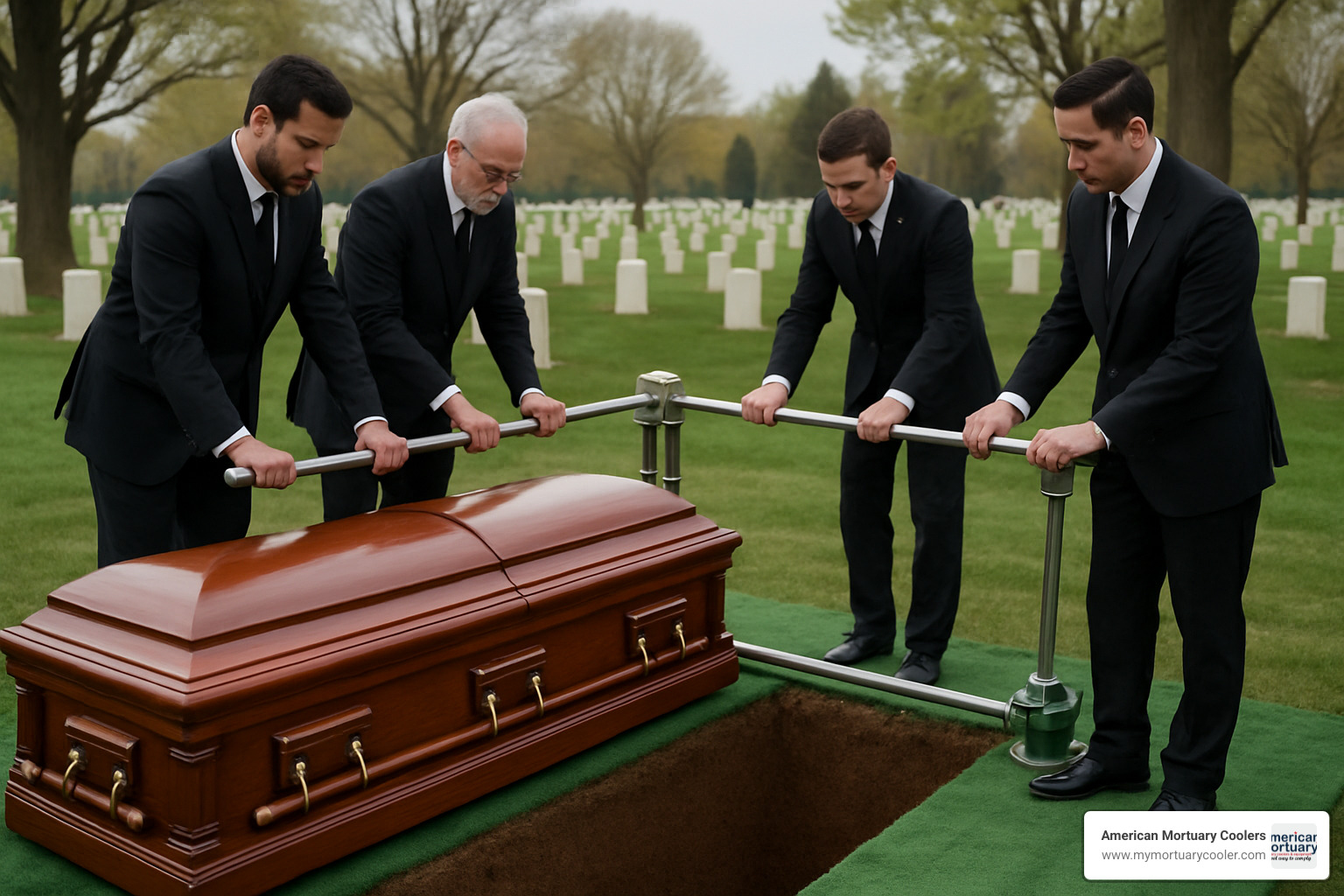
Step-by-Step Setup & Takedown
There's something deeply reassuring about a perfectly executed graveside service. The heart of this ceremony often rests on the smooth, dignified operation of your casket lowering device.
Before the service begins, preparation is key. Start by ensuring the ground around the grave is level and stable—uneven terrain can lead to wobbling or tilting during the critical moment of lowering. Many professionals place wooden support bars across the grave opening, providing additional stability during the initial setup.
Positioning is everything. The device stand should be adjusted to an appropriate height, typically between 17 and 27 inches, depending on the grave depth and service requirements. Once your stand is in place, center the lowering device directly over the grave. This is when you'll extend those telescoping side rails to match your casket's dimensions, securing all sections with the spring-loaded buttons or eccentric sleeves.
"Always double-check your braking system before placing the casket," advises one veteran funeral director. "It's a small step that prevents big problems."
The straps require careful attention too. They should lay flat across the wooden support bars (if used) and extend fully across the width of the device. A twisted strap not only looks unprofessional but can cause uneven lowering.
When it's time to place the casket, placer arms can help guide it gently onto the device. The casket should be centered precisely over the straps for balanced descent. Once in position, any placer arms can be removed, creating a clean visual presentation for the family and attendees.
The actual lowering process requires a steady hand and careful attention. First, remove any wooden support bars. Then, with deliberate movements, disengage the brake using the stainless steel crank handle or release mechanism. The beauty of a quality casket lowering device is in its centrifugal governor, which will automatically control the descent speed regardless of the casket's weight.
After the casket reaches the bottom, you'll need to retrieve your straps. Build a small mound of soil or use vault bumpers to lift the casket slightly, then gently pull the straps free. Most professionals immediately rewind the straps using the crank handle to prevent tangling or soiling.
Finally, collapse those telescoping rails, remove the device from the stand, and carefully pack everything for transport. This care ensures your equipment will be ready for the next service.
Safety Features & Best Practices
Safety during a burial service isn't just about preventing accidents—it's about maintaining the dignity of a solemn moment. Your casket lowering device comes equipped with thoughtful safety features that serve both purposes.
The adjustable braking system is perhaps the most important safety feature, preventing any possibility of uncontrolled descent regardless of casket weight. This system ensures that whether you're handling a lightweight infant casket or a heavy oversized unit, the lowering speed remains consistent and dignified.
Safety chains provide peace of mind as a backup support system. These standard 54-inch chains (68 inches including hooks) can prevent catastrophic failure even in the unlikely event of a primary system issue. "I've only needed them once in fifteen years," shares one cemetery manager, "but that one time made them worth every penny."
Respecting load ratings isn't just a recommendation—it's a necessity. Most professional devices handle between 800-1,000 pounds, but always verify your specific model's capacity. Exceeding these limits puts unnecessary stress on components and can lead to premature wear or failure.
The locking mechanisms on telescoping rails deserve special attention during your pre-service inspection. These prevent collapse during use and should engage firmly with an audible click or visible indicator.
Before each service, develop the habit of conducting a thorough inspection. Check all components for signs of wear, damage, or corrosion, with special attention to straps—replace them at the first sign of fraying. Verify the casket weight is within rated capacity, and ensure your device sits level and stable before placement.
Weather considerations matter too. While quality devices function in all conditions, extra precautions on windy days or in extreme weather can prevent problems. Having alternative lowering methods available provides backup options in case of mechanical issues.
At American Mortuary Coolers, we've found that proper staff training makes all the difference. When everyone understands correct setup procedures and emergency protocols, services run smoothly even when challenges arise.
Maintenance, Repair & Budget Planning
A well-maintained casket lowering device can become a trusted partner in your funeral services for decades. Taking care of this investment doesn't require complicated procedures—just consistent attention.
After each use, take a few moments to wipe down the frame and mechanisms, removing any dirt or debris that could affect future performance. This is also the perfect time to inspect straps for wear or damage and verify smooth operation of all moving parts. These small checks prevent small problems from becoming big ones.
Monthly maintenance is equally straightforward. Apply the recommended gear grease to specified points—usually just a small amount at key joints and mechanisms. Check all fasteners for tightness, as the repeated setup and takedown can gradually loosen connections. Many professionals also perform a quick test of the braking system under no-load conditions to ensure everything operates smoothly.
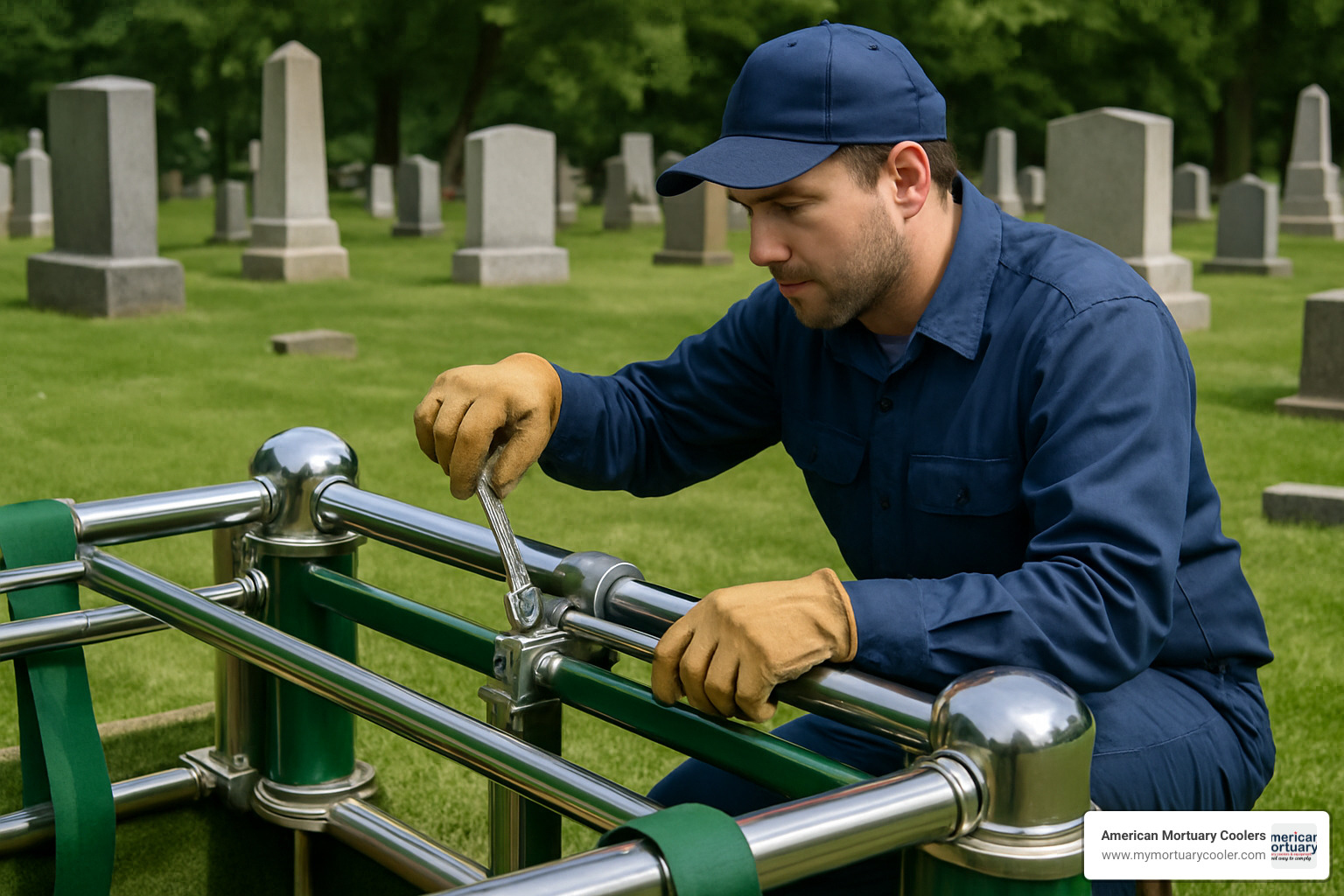
Annual maintenance deserves more attention. Consider scheduling a comprehensive inspection of all components, replacing worn parts proactively rather than reactively. Many funeral homes work with specialists like Garcia's Lowering Device Service, who have "serviced and trained over 30 Veteran National Cemeteries" and offer expertise that extends equipment lifespan.
When repairs become necessary, you have options. On-site service companies like Garcia's offer nationwide repair "rain or shine," bringing expertise directly to you. For older devices, complete rebuilds can breathe new life into trusted equipment. As one provider proudly states, "We offer a full 12-month warranty on all repaired or replaced parts."
For budget planning, consider the full lifecycle of your equipment. New devices range from $4,000 to $13,000 depending on model and accessories—a significant investment that deserves protection. For occasional use facilities, rental may be more economical than purchase.
When calculating return on investment, quality devices often serve for 20+ years with proper maintenance. This long lifespan dramatically reduces the per-service cost compared to budget models that require frequent replacement. Many suppliers offer payment plans specifically designed for funeral industry equipment, easing the initial financial impact.
A smart approach is allocating approximately 5-10% of the purchase price annually for maintenance and repairs. This creates a reserve fund for both routine care and unexpected issues, preventing maintenance decisions from being influenced by immediate budget constraints.
As we've heard from countless funeral directors across our service regions from Chicago to Dallas, "The initial investment in a quality device pays for itself through reliability and reduced ceremony stress." At American Mortuary Coolers, we help customers determine the most cost-effective equipment strategy for their specific needs, balancing quality, longevity, and budget requirements.
Conclusion
Selecting the right casket lowering device represents a significant investment in your funeral home's ability to provide dignified, professional graveside services. From the mechanical precision of the internal gearing to the aesthetic presentation created by quality drapes and stands, every component contributes to the solemn ceremony families expect and deserve.
At American Mortuary Coolers, we understand that funeral equipment must balance durability, functionality, and ceremonial dignity. We're not just selling equipment – we're helping you create meaningful moments for families during their most vulnerable times. Based in Tennessee with service locations across the country—from New York to Los Angeles and Chicago to Dallas—we're uniquely positioned to help funeral professionals select, maintain, and optimize their cemetery equipment.

Our commitment to the funeral industry extends beyond simply supplying equipment. We provide customized solutions that consider your specific needs, cemetery conditions, and budget requirements. Whether you operate in the humid Southeast or the variable climate of the Midwest, we can recommend the appropriate casket lowering device configuration that will stand up to your local conditions while providing the reliability you need when it matters most.
The evolution of casket lowering technology from early 20th-century patents to today's sophisticated systems reflects our industry's ongoing commitment to dignity and safety. There's something deeply reassuring about equipment that performs flawlessly during life's most emotional moments – it's one less thing for you to worry about when helping families say goodbye.
By investing in quality equipment, implementing proper maintenance protocols, and training your staff thoroughly, your funeral home can ensure that this critical moment in the farewell ceremony proceeds with the respect and reverence families deserve. After all, these aren't just mechanical devices – they're tools that help create lasting memories during life's most difficult transitions.
For more information about casket lowering devices or other mortuary equipment needs, please contact us at American Mortuary Coolers. As your one-stop shop for mortuary coolers and related equipment, we're here to support your mission of providing exceptional care during life's most challenging moments. We understand the unique pressures of funeral service, and we're committed to being a partner you can count on when every detail matters.
















